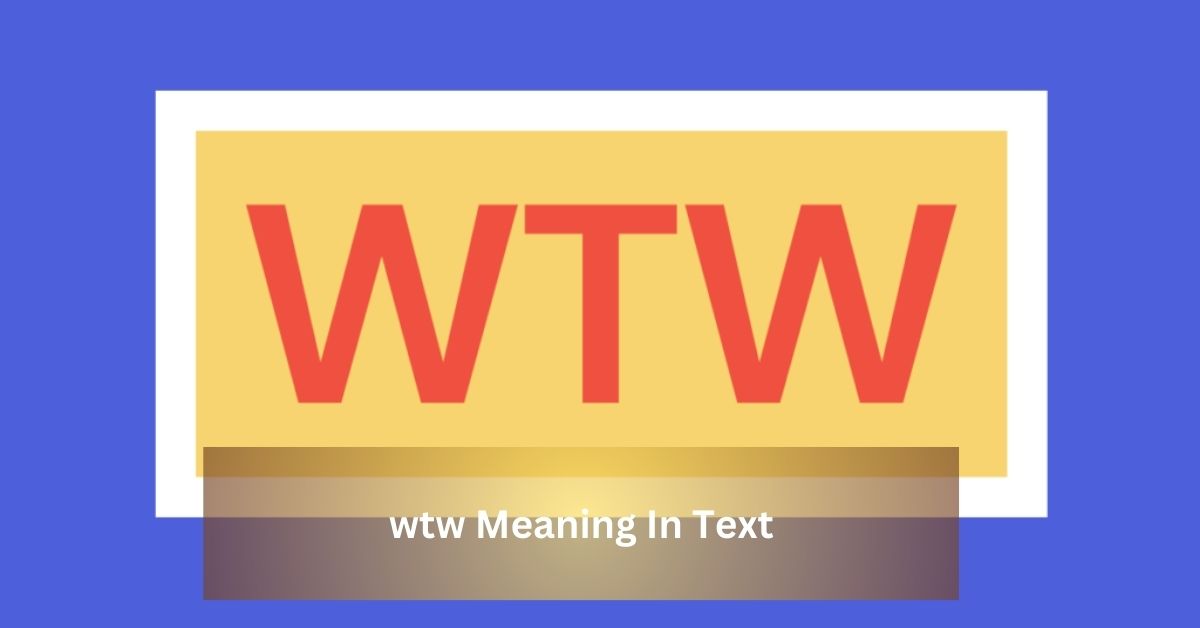In the fast-paced world of digital communication, where brevity is often valued over verbosity, acronyms and shorthand play a significant role in conveying messages efficiently. Among the myriad of abbreviations used in text messages, “WTW” stands out as a commonly encountered phrase.
But what exactly does it signify? This article aims to explore the meaning and usage of “WTW meaning in text messages, shedding light on its origins, contextual usage, and its implications for communication in the digital age.
Understanding the Origin:
“WTW meaning” is an acronym derived from the phrase “What’s the word?” This shorthand expression emerged from the need to convey curiosity or interest in a concise manner, particularly in the context of digital conversations where speed and efficiency are paramount.
By condensing the phrase into three letters, “WTW” enables individuals to initiate conversations or inquire about updates with ease, reflecting the adaptability of language in the digital realm.
Contextual Usage:
The usage of “WTW” is highly contextual, often employed as an icebreaker or conversation starter. When used at the beginning of a chat, “WTW” serves as a casual inquiry into the recent events or updates in someone’s life.
Its versatility allows it to be utilized in various situations, from catching up with friends to initiating discussions in group chats or online forums. Understanding the appropriate context for using “WTW” enhances its effectiveness as a communication tool.
Alternatives and Variations:
While “WTW” is the predominant abbreviation for “What’s the word?” in text messages, there exist alternative expressions that convey similar meanings.
Phrases like “What’s up?” or “What’s new?” serve as interchangeable options, offering individuals flexibility in choosing their preferred mode of communication.
The widespread adoption of these variations underscores the diverse linguistic landscape of digital communication, where language evolves organically to meet the needs of its users.
Informal Tone:
The use of “WTW” contributes to the informal tone prevalent in digital conversations. By employing shorthand and abbreviations, individuals can communicate in a relaxed manner, devoid of the formalities often associated with written communication.
This informality fosters a sense of camaraderie and ease, facilitating seamless interactions across various social and digital platforms.
Social Media and Messaging Platforms:
The proliferation of social media and messaging platforms has further popularized the use of abbreviations like “WTW.”
These platforms offer a conducive environment for quick exchanges, prompting users to embrace succinct expressions to convey their thoughts efficiently.
Whether through text messages, status updates, or comments, the prevalence of “WTW” reflects the evolving nature of language in the digital age, where brevity is valued alongside clarity and expression.
Cultural and Generational Influence:
The widespread adoption of “WTW” and similar acronyms is indicative of the cultural and generational influences shaping modern communication norms.
As digital natives continue to dominate online discourse, the use of shorthand and abbreviations has become ingrained in everyday communication practices.
The fluidity of language allows for constant innovation and adaptation, with expressions like “WTW” serving as markers of linguistic evolution in the digital era.
Clarifying Misinterpretations:
While abbreviations like “WTW” streamline communication, they can also lead to misinterpretations if not contextualized properly.
It’s crucial to consider tone, context, and audience expectations to ensure effective communication and prevent misunderstandings.
Embracing clarity and precision in digital interactions promotes meaningful engagement and fosters stronger connections in an increasingly interconnected world.
Evolution of Digital Slang:
The emergence and widespread adoption of abbreviations like “WTW” are part of a broader evolution of digital slang and shorthand in online communication.
As technology continues to shape the way we interact and communicate, language adapts accordingly to accommodate the fast-paced and often informal nature of digital exchanges.
From the early days of instant messaging to the present era of social media platforms and messaging apps, digital slang has become an integral aspect of online discourse, reflecting the dynamic evolution of language in the digital age.
Cross-Cultural Adaptation:
The use of “WTW” and similar abbreviations transcends geographical and cultural boundaries, highlighting the universal appeal of shorthand in digital communication.
While the origins of specific acronyms may be rooted in certain linguistic contexts or communities, their adoption and adaptation across different cultures demonstrate the global interconnectedness facilitated by the internet.
Cross-cultural communication norms continue to evolve as individuals navigate linguistic diversity and exchange ideas in increasingly interconnected online spaces.
Psychological Implications:
The use of shorthand and abbreviations like “WTW” can have psychological implications on communication dynamics and interpersonal relationships.
In digital environments where brevity is valued, the use of concise expressions may enhance efficiency and streamline interactions.
However, overreliance on abbreviations can also lead to a loss of nuance and depth in communication, potentially hindering meaningful connections and emotional expression.
Understanding the balance between brevity and clarity is essential for fostering genuine communication in digital contexts.
Linguistic Adaptation in Education:
The prevalence of digital slang, including abbreviations like “WTW,” poses challenges and opportunities for educators and language instructors.
As students increasingly incorporate digital communication habits into their written and spoken language, educators must navigate the balance between teaching formal language conventions and acknowledging the evolving nature of communication in the digital age.
Integrating discussions about digital slang into language curricula can help students develop critical language awareness skills and adapt to the complexities of contemporary communication.
Future Trends and Innovations:
Looking ahead, the evolution of digital communication is likely to continue shaping language usage and linguistic norms.
As technology advances and new platforms emerge, individuals will continue to innovate and create novel ways of expressing themselves in digital environments.
Predicting future trends in digital slang and shorthand, including the evolution of expressions like “WTW,” requires ongoing observation and analysis of linguistic patterns, cultural shifts, and technological developments.
Embracing the fluidity of language and remaining open to linguistic innovations will be key in navigating the ever-changing landscape of digital communication.
Conclusion:
In conclusion, “WTW” serves as a shorthand expression for “What’s the word?” in text messages, embodying the informal and efficient nature of digital communication.
By understanding its origins, contextual usage, and implications, individuals can leverage “WTW” as a tool for initiating conversations, fostering connections, and navigating the complexities of modern communication.
As language continues to evolve in the digital age, abbreviations like “WTW” exemplify the adaptability and dynamism of human expression in an ever-changing linguistic landscape.
FAQs
what does wtw mean in texting
WTW” in texts means “What’s up?” or “What’s the word.” It’s a casual greeting or inquiry about current status.
what does wtw mean on snapchat
On Snapchat, “WTW” means “What’s happening?” It’s used to ask about someone’s current activity or plans.


